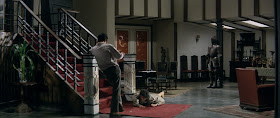Guess What's Coming to Dinner?, or: The Amnesiacs
(All images are details from iPhone photos taken of the film playing on the Criterion Blu-ray disc; no screen-capturing is capable during playback.)
===
A furious montage, then we learn that objects are too fleeting and, so, too silent to yield up symbolic interpretation — if, if we're looking hard enough. These are zero-hand, 1.5-hand, items. They permafrost the flat at first glance but will ostensibly be sold at appointment by their merchant Hélène (Delphine Seyrig). Clearly, dig the ambiguity around the whole situation with these solids. For example: what of Seyrig in this wig — an item like the rest? We think of Hitchcock, or: we think of Godard thinking of Hitchcock — as he says in the
Histoire(s) du cinéma Alfred's
"the inventor of forms."
And Bernard (Jean-Baptiste Thierrée) says:
"You never know what period you'll wake up to in this place." I pause personally not so much at
"this place" as I do
"wake up to".
Muriel, ou le Temps d'un retour [
Muriel, or: The Time of a Return, 1963] is no dream-saga or cannot be so easily internalized as such regardless of
Last Year at Marienbad — this is dedicated hardcore montage form confronting and abutting in certain prolongation Cocteau, materially.
The town of Boulogne (or Boulogne-sur-Mer) — is there such a place? Was there? Whatever you do, don't ask Hélène. We see it starkly in the light of day, concealed at night except in neon or half-shadow,
Jeanne Dielman's Brussels with a casino. Present-time and morning-after, then back, or not — eruptions of time immemorial, frozen, eternal, personages present or not... place, place, place... More profoundly strange than Marienbad, Hiroshima, Nevers. And Algiers is the Mission San Juan Bautista.
Nearly twenty years after the Liberation. Muriel Carlotta is the victim of a war crime that Bernard participated in the act of — or observed — during his time in Algeria, 'down-there.'
Does a fight between friends mean you're finished for life? No, not a war-crime — an argument, a misunderstanding. But
what misunderstanding! Alphonse Noyard (Jean-Pierre Kerien) (character's last name an emendation of
noyé, par exemple, des clochards) has this put-on about having owned a café down-there, constructed history, but in essence he's a lunatic who cut free from the asylum. However: look at proximate cause. (Paradoxical thoughitsobe: for
Muriel is one of the greatest films about cause-and-effect, which is to say, the lack thereof, ever made, existentialist Sartrean strain.) Who in this menagerie could make a fair claim to moral high-ground, or to truth? Hélène is a lie, Bertrand is a lie, Françoise (Nita Klein) is a lie. Property, ownership, is a lie.
Hélène, Alphonse, and Françoise march to the entrance of Hélène's building (one of the four post-war Neubauten of Boulogne), cuts between them twelve-tone, chromaticism in the close-ups (the storied detail: no camera movements in
Muriel till the last shot). Hélène:
"Many died, were shot. I don't remember how many." Bob Dylan:
"From the boat I fish for bullheads — / I catch a lot, sometimes too many."
Françoise:
"This is paradise."
Hélène's bedroom at one point functions as an impromptu dining room, or vice-versa. (All the furniture and appointments are in flux from scene to scene.) The Hélène-Alphonse relationship is often swapped/echoed with the Hélène-Bernard relationship: after Alphonse shows up, she says,
"The two of us should have gone into hiding."
Bernard:
"I don't want to be a filmmaker. I'm just collecting evidence."
The Alsatians say,
Merci vielmol. Two shandies. •
===
More writing at
Cinemasparagus on the films of Alain Resnais:
Nuit et brouillard [Night and Fog, 1955]
Le chant du styrène [The Song of the Styrene, 1958]
Hiroshima mon amour [Hiroshima My Love, 1959] — a piece I regret now, from 2007
===















